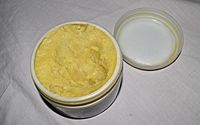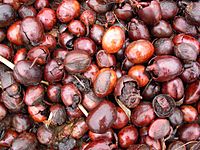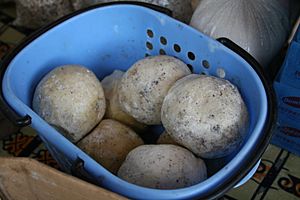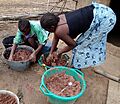Shea butter facts for kids
Shea butter is a special kind of fat that comes from the nut of the African shea tree (Vitellaria paradoxa). When it's natural, it looks like ivory, but sometimes it's dyed yellow using borututu root or palm oil. People use shea butter a lot in cosmetics to make skin soft, like a moisturizer or lotion. It's also safe to eat and is used in cooking in some African countries. Sometimes, it's mixed with other oils to replace cocoa butter, even though it tastes a bit different.
The word "shea" comes from the Bambara language in Mali. It has many local names, like kpakahili in Dagbani, nkuto in Twi, and òrí in Yoruba.
Contents
Where Shea Butter Comes From
The shea tree grows naturally in the wild, mostly in the dry savannah areas of West Africa. You can find it from Senegal in the west all the way to Sudan in the east, and even near the Ethiopian highlands. It grows in 21 countries across Africa, including Benin, Burkina Faso, Ghana, Mali, and Nigeria.
People have been making shea butter for a very long time. We know it was being made by the 14th century, and it was even brought to Britain by 1846.
What's Inside Shea Butter
Shea butter is a special kind of fat. It has many good things in it, including different fatty acids like oleic acid and stearic acid. It also contains important vitamins such as A, E, and F.
Shea butter melts when it touches your skin, which is why it's so easy to use. It soaks into the skin quickly and helps it stay soft and hydrated.
How Shea Butter is Used
Shea butter is mostly used in the beauty industry. You can find it in products for your skin and hair, like lip gloss, lip stick, skin moisturizers, and hair conditioners, especially for dry hair.
Soap makers also use shea butter. It helps make soap soft and moisturizing. However, it's quite expensive compared to other oils, so it's not always used in large amounts in soaps you buy in stores. It's really good at making dry skin feel better. While it doesn't cure skin problems, it can help with discomfort like tightness and itching.
In some African countries like Benin, shea butter is used for many things. People use it as cooking oil, to make things waterproof, for styling hair, and even for making candles. It's also an ingredient in some traditional medicines. Makers of African percussion instruments use it to make wood and leather last longer.
Shea Butter for Health
Shea butter is sometimes used as a base for ointments. Some parts of shea butter are known to help fight germs, reduce swelling, and keep skin moist. It has also been used as a sunblocking lotion with a small amount of sun protection (around SPF 3–4). It can absorb some ultraviolet radiation from the sun.
In Ghana, shea butter is called Kpakahili or nkuto. People use it as food or put it on their skin to protect it during the dry Harmattan season. The city of Tamale in Ghana even got its name from the local word for shea fruits!
In Nigeria, shea butter is used to help with sinusitis and nasal congestion. People also massage it into their joints and other body parts to help with pain.
Different Types of Shea Butter
There's a way to classify shea butter into different types, or grades:
- Grade A: This is raw or unrefined shea butter. It's made using water and has a creamy to grayish-yellow color. It also has a nutty smell.
- Grade B: This is refined shea butter.
- Grade C: This is highly refined shea butter, often made using special chemicals. It is pure white and usually doesn't have a smell.
- Grade D: This is the lowest grade that is still clean.
- Grade E: This grade has contaminants.
The types you usually find for sale are Grades A, B, and C. When shea butter is refined (like Grade C), it can lose a lot of its vitamins, sometimes up to 95%. However, refining also makes it very clean by removing impurities.
Images for kids
de:Karitébaum#Sheabutter Vitellaria paradoxa#La manteca de Karité








